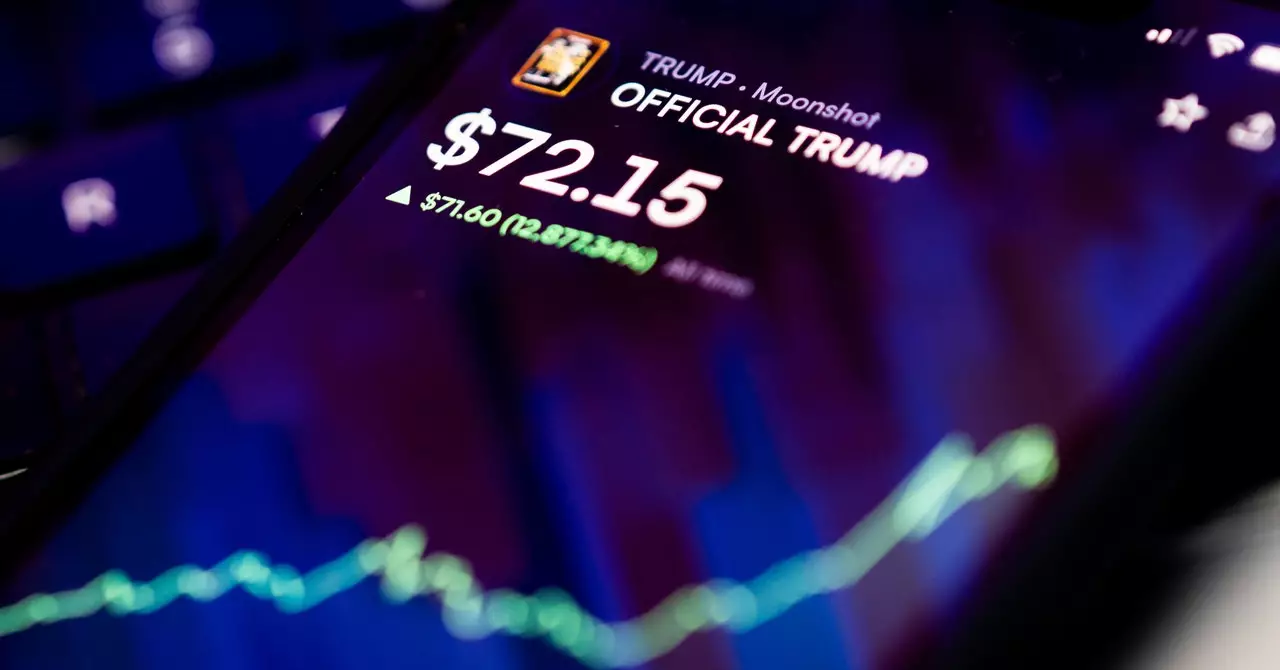The rise of cryptocurrency has ushered in a new era of digital finance, but it has also paved the way for dubious ventures that can jeopardize the financial wellbeing of investors. One such project drawing significant scrutiny is the TRUMP coin, a new memecoin linked to the former President Donald Trump. The concept of political memecoins like TRUMP raises essential questions regarding ethical practices in cryptocurrency, the influence of celebrity endorsements, and potential implications for political sway.
At the heart of the TRUMP coin’s controversy is its alleged structure, which some experts claim mirrors the operational tactics of a “pump-and-dump.” This scheme typically involves insiders manipulating the market by heavily investing in promotional efforts while retaining a substantial portion of the coin’s total supply. When the hype reaches its peak, these insiders cash out, leading to a dramatic decrease in the coin’s value. Jacob Silverman, co-author of “Easy Money,” points out that with 80 percent of the TRUMP token’s distribution in the hands of insiders, the risks of substantial sell-offs loom large. Such scenarios reveal a broader concern around memecoin ethics, often confined to a murky legal framework while being starkly denounced on moral grounds.
The financial landscape surrounding memecoins can often resemble a high-stakes gambling environment, where uninformed investors may take their cues from social media trends and the endorsement of public figures. With the power dynamic shifting, it becomes increasingly apparent that the average investor could find themselves on the losing end of these transactions—what Silverman terms as the inevitable “soaking” of “poor saps.” It highlights a troubling aspect of the cryptocurrency space: the intertwining of entertainment, speculation, and potential financial ruin.
As if the mere existence of TRUMP weren’t complicated enough, the coin has further repercussions for similar projects. For example, Melania Trump’s launch of her own memecoin swiftly catalyzed a 50% drop in the value of the TRUMP token. This phenomenon is indicative of a larger trend where competing political-themed cryptocurrencies significantly influence each other’s fortunes. Other unofficial Trump-themed coins also faced similar declines. This decline elucidates how the cryptocurrency market is often shaped by narratives rather than fundamentals, leaving investors vulnerable to sudden shifts spurred by external launches and media attention.
Moreover, the dynamics surrounding political memecoins cannot be overlooked. During the upcoming 2024 election cycle, coins have become proxies for supporters to place bets on political outcomes. This behavior underlines an uncharted territory where financial speculation and political allegiance intersect, creating a swirling storm of influences that could imperil both investor confidence and political legitimacy.
The consequences of the TRUMP coin extend beyond mere financial losses; they raise ethical alarms regarding the potential for bribery and political influence. Silverman argues that individuals could use substantial investments in TRUMP, bolstered by Trump’s financial interests, to create a channel of influence over the former president. This development poses a significant risk to the integrity of both cryptocurrency and political systems, as it fosters an environment where monetary contributions can be disguised as speculative investments. Such complexities beg the question: how far will the normalization of cryptocurrency extend into the political arena, and at what cost?
While Trump’s previous denouncements of Bitcoin as a “scam” may seem contradictory, his newfound embrace of cryptocurrency positions him as a burgeoning advocate for the industry—paradoxically dubbed the “crypto president.” As he courted crypto leaders for financial backing, he masterfully shifted the public narrative, channeling support from this rapidly growing segment. Yet, skepticism abounds around Trump’s latest forays into cryptocurrency, such as the launch of World Liberty Financial. Many industry experts are wary that these ventures might ultimately lead to backlash against the crypto industry if they fail.
Reflecting on the evolving relationship between Trump and cryptocurrency, one cannot help but observe that while he appears to align himself with a burgeoning financial revolution, it is fraught with risks for investors. The lack of transparency and rigorous regulations, especially as it pertains to his influence over the future of the SEC, reveals an unsettling irony: the very fabric of cryptocurrency’s independence could be compromised by the political whims of its most prominent endorsers.
In summation, the emergence of the TRUMP coin encapsulates the multifaceted challenges inherent in the interplay of politics, cryptocurrency, and speculation. As investors grapple with the risks posed by memecoins, the volatility tied to political endorsements necessitates a cautious approach to investment in this unpredictable landscape. With financial ecosystems increasingly rife with dubious practices and ethical dilemmas, the TRUMP coin saga serves as a stark reminder of the potential pitfalls lurking in the new frontier of digital finance.

